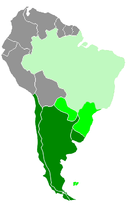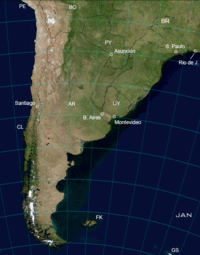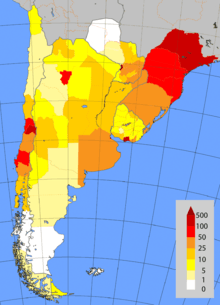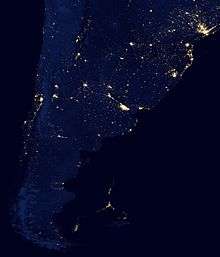Southern Cone
| Southern Cone | |
|---|---|
 | |
| Area | 4,944,081 square kilometres (1,908,920 sq mi) |
| Population | 135,707,204 (July 2010 est.) |
| Density | 27.45/km2 (71.1/sq mi)[1] |
| Countries | 3, 4, or 5 |
| Dependencies | 18 |
| Demonym | South American |
| Languages | Spanish, Portuguese, indigenous languages, and many others |
| Largest urban agglomerations (2010) |
1. 2. 3. 4. 5. 6. 7. |
Southern Cone (Spanish: Cono Sur, Portuguese: Cone Sul) is a geographic region composed of the southernmost areas of South America, south of and around the Tropic of Capricorn. Traditionally, it covers Argentina, Chile and Uruguay, bounded on the west by the Pacific Ocean, and south to the junction between the Pacific and Atlantic Oceans, which is the closest continental area of Antarctica (1000 km). In terms of social and political geography, the Southern Cone comprises Argentina, Chile, Uruguay, Southern Brazil and sometimes Paraguay.[2]
High life expectancy, the highest Human Development Index of Latin America, high standard of living, significant participation in the global markets and the emerging economy[3] of its members make the Southern Cone the most prosperous macro-region in Latin America.[2][4][5]
Geography and extent


The climates are mostly temperate, but include humid subtropical, Mediterranean, highland tropical, maritime temperate, sub-Antarctic temperate, highland cold, desert and semi-arid temperate regions. Except for northern regions of Argentina (thermal equator in January), the whole country of Paraguay, the Argentina-Brazil border and the interior of the Atacama desert, the region rarely suffers from heat. In addition to that, the winter presents mostly cool temperatures. Strong and constant wind and high humidity is what brings low temperatures in the winter. The Atacama is the driest place on Earth.
One of the most peculiar plants of the region is the Araucaria tree, which can be found in southern Brazil, Chile and Argentina. The only native group of conifers found in the southern hemisphere had its origin in the Southern Cone. Araucaria angustifolia, once widespread in Southern Brazil, is now a critically endangered species, protected by law. The steppe region of central Argentina, Uruguay and southern Brazil is known as the Pampas.
Central Chile has Mediterranean vegetation and climate, grading southward into oceanic climate. The Atacama, Patagonian and Monte deserts form a diagonal or arid lands separating the woodlands, croplands and pastures of La Plata basin from Central and Southern Chile. Apart from the desert diagonal, the north-south running Andes form a major divide in the Southern Cone and constitute, for most of its part in the southern cone, the political border of Chile. In the east the river systems of the La Plata basin form natural barriers and sea-lanes between Argentina, Brazil, Paraguay and Uruguay.
| Location | Warmest month | April | Coldest month | October |
|---|---|---|---|---|
| Ciudad de Buenos Aires[6] | 29.9 °C (85.8 °F) 19.6 °C (67.3 °F) |
22.8 °C (73.0 °F) 13.3 °C (55.9 °F) |
15.4 °C (59.7 °F) 7.6 °C (45.7 °F) |
22.1 °C (71.8 °F) 12.7 °C (54.9 °F) |
| Santiago de Chile[7] | 29.7 °C (85.5 °F) 13.0 °C (55.4 °F) |
24.3 °C (75.7 °F) 8.0 °C (46.4 °F) |
14.9 °C (58.8 °F) 3.9 °C (39.0 °F) |
25.3 °C (77.5 °F) 10.6 °C (51.1 °F) |
| Porto Alegre | 30.2 °C (86.4 °F) 20.5 °C (68.9 °F) |
25.2 °C (77.4 °F) 16.3 °C (61.3 °F) |
20.3 °C (68.5 °F) 10.7 °C (51.3 °F) |
24.4 °C (75.9 °F) 15.0 °C (59.0 °F) |
| Asunción | 33.5 °C (92.3 °F) 22.8 °C (73.0 °F) |
28.4 °C (83.1 °F) 18.6 °C (65.5 °F) |
23.2 °C (73.8 °F) 13.1 °C (55.6 °F) |
29.2 °C (84.6 °F) 18.6 °C (65.5 °F) |
| Montevideo | 28.4 °C (83.1 °F) 18.0 °C (64.4 °F) |
22.0 °C (71.6 °F) 12.9 °C (55.2 °F) |
15.0 °C (59.0 °F) 7.2 °C (45.0 °F) |
20.5 °C (68.9 °F) 11.5 °C (52.7 °F) |
Culture

Besides sharing languages and colonial heritage, the residents of the states of the Southern Cone are avid players and fans of football (US: soccer), with top-notch teams competing in the sport. Argentina and Uruguay have both won the FIFA World Cup twice; they are the only national teams along with Brazil outside Europe to have won the cup. Argentina, Chile and Uruguay, and most recently, Brazil, have all hosted the World Cup. America's Cup 2015 was won by the hosts, Chile. Additionally, national teams from the region have won several Olympic medals in football. Also, football clubs from the Southern Cone countries have won large numbers of club competitions in South-American competitions, Pan-American competitions, and world-FIFA Club World Cup-level competitions.
The asado barbecue is a culinary tradition typical of the Southern Cone. The asado developed from the horsemen and cattle culture of the region, more specifically from the gauchos of Argentina and Uruguay (and Southern Chile) and the huasos of Chile. In the Southern Cone, horsemen are considered icons of national identity; they are featured in the epic poem Martín Fierro. Mate is popular throughout the Southern Cone, especially in Argentina, Paraguay and Uruguay. In Chile mate is popular in the southern regions and south-central rural areas.
In this area, there was extensive European immigration during the 19th- and 20th-centuries, who, with their descendants, have strongly influenced the culture, social life and politics of these countries. They helped organize labor movements and popular movements for democracy but also participated in the dictatorships.
Language
The overwhelming majority, including those of recent immigrant background, speak Spanish (in Argentina, Chile and Uruguay) or Portuguese in the case of Southern Brazil. The Spanish-speaking countries of the Southern Cone are divided into two main dialects:
- Castellano Rioplatense (River plate Spanish), spoken in Argentina and Uruguay, where the accent and daily language is heavily influenced by 19th-20th century Italian immigrants, has a particular intonation famously recognized by Spanish speakers from around the world. It is sometimes erroneously referred to as "Castellano Argentino/Argentinean Spanish" due to the majority of the speakers (by population) being Argentinians. Preliminary research has shown that Rioplatense Spanish, has intonation patterns that resemble those of Italian dialects in the Naples region, and differ markedly from the patterns of other forms of Spanish.[8] Buenos Aires, Rosario, and Montevideo had a massive influx of Italian immigrant settlers from the mid-19th until mid-20th centuries. Researchers note that the development of this dialect is a relatively recent phenomenon, developing at the beginning of the 20th century with the main wave of Italian immigration.[9]
- Castellano Chileno (Chilean Spanish), Recognized by its fast speed and loose pronunciation, has been influenced by 19th-20th century German immigrants. The daily informal language of Chile is characterized by the highly loose use of the "s" sound. Due to this, the Chilean speaker pronounces singular and plural words in a similar fashion.[10]
These dialects share common traits, such as a number of Lunfardo and Quechua words.
Other minor languages and dialects include Portuñol, a hybrid between Rioplatense and Portuguese.
Native American languages
Some Native American groups, especially in rural areas, continue to speak autochthonous languages, including Mapudungun (also known as Mapuche), Quechua, Aymara, and Guarani. The first is primarily spoken in Araucanía and adjacent areas of Patagonia, in southern Argentina and Chile. Guarani is spoken in the northeastern Argentine provinces of Corrientes and Misiones, where it is an official language along with Spanish.[11]
Non-Iberian European languages
English is spoken in the Falkland Islands, a British Overseas Territory. Welsh is spoken by descendants of immigrants in the Patagonia region of Argentina. Portuñol (Portunhol in Portuguese), is a pidgin or creole language of Brazilian Portuguese and Spanish that is spoken on the border with Brazil.
Italian (mostly its Northern dialects, such as Venetian), is spoken in rural communities across Argentina and Southern Brazil where immigrants had settled. German in some dialects is mostly spoken in Southern Chile and Southern Brazil. Croatian and other Slavic languages are also spoken in the southernmost areas of Chilean Patagonia, reflecting patterns of immigration and settlement.
Religion

The majority of residents are Roman Catholic, but there are Jewish and Protestants as well (mostly in Argentina and Chile). Religions include Islam, Anglican, Lutheran, Eastern Orthodox, Buddhism and Dao. Jewish communities have thrived in cities of Argentina and Uruguay.
While the Southern Cone has been conservative in some aspects of religion, it has had a tradition of social reform and "liberation theology" has been followed by many in the Catholic Church. Uruguay, where agnosticism and atheism is common, has a policy of strong separation of church and state. It is one of the most secular countries in the Americas.[12] Uruguay, Argentina and Chile, in that order, have the least religious residents in South America, according to their responses about the significance of religion in their lives. According to a Gallup poll, 51% of Uruguayans, 56% of Argentines, and 60% of Chileans think of religion 'as something important in their lives,' contrasting with the higher values given by the residents of countries such as Brazil (87%), Bolivia (89%) and Paraguay (92%). In another social survey, residents rated their countries as 'good places for gay or lesbian people to live;' the following percentages said 'yes' in Uruguay (69%), Argentina (58%) and Chile (52%). By contrast, fewer people in the following countries agreed: Bolivia (24%), Ecuador (31%) and Peru (32%).[13]
Countries and territories
| Country or territory |
Area (km²)[14] |
Population (2011)[14] |
Population density (per km²) |
Capital or most important city |
|---|---|---|---|---|
| |
2,780,400 | 40,091,359 | 14.42 | Buenos Aires |
| |
756,096 | 17,094,275 | 22.60 | Santiago |
| |
176,215 | 3,424,595 | 19.43 | Montevideo |
| Total | 3,712,711 | 60,610,229 | 16.32 |
Demography


The population of Argentina, Chile and Uruguay is 40, 16.8 and 3.6 million respectively. Buenos Aires is the largest metropolitan area at 13.1 million and Santiago, Chile has 6.4 million. Uruguay's capital and largest city, Montevideo, has 1.8 million, and it receives many visitors on ferry boats across the Río de la Plata from Buenos Aires, 50 km (31 mi) away.
Ethnicity
As far as ethnicity is concerned, the population of the Southern Cone has been strongly influenced by waves of immigration from Europe in the late nineteenth and early twentieth centuries. For instance, People of European descent, make up 94% of the total population of Argentina and 96% of total population of Uruguay and 53% of total population of Chile.[15][16][17][18] Mestizos make up 15.8% of the population and are a majority in Paraguay. Native Americans make up 3% of the population, mulattoes (people of European and African ancestry) mostly in Uruguay (0.2%), and Asians (1.0%), mostly in Argentina, the remaining 1.2%.[19] The White population in Brazil is spread throughout the national territory, but its highest percentage is found in the three southernmost states, where 79.8% of the population has European or Caucasian phenotype, whereas the Southeast region has the largest absolute numbers.[20] Santa Catarina is the state with the highest percentage of European ancestry citizens (86.96%),[21] while São Paulo has the largest population in absolute numbers with 30 million Whites.[22]
Due to the large 19th and 20th centuries immigration influx, today in absolute numbers, Argentina and Brazil altogether have 84 million Spaniards and Portuguese people, 52 million Italian descendants, 20 million citizens whose ancestry is traced back to German-speaking nations or areas (i.e. Germany, Austria, Switzerland, Luxembourg, Pomerania, Prussia and Volga Germans from Russia), being home to the largest German diasporas after the United States, 9 million Slavs, 8 million French, 2.5 million Dutch and Belgians, 2 million Scandinavians, 900 thousand Lithuanians, 600 thousand Hungarians, 400 thousand Ashkenazi and Sephardi Jews, and 200 thousand Finns. Besides 2.6 million East Asians, mostly Japanese, and 13 million Levantine Arabs. Argentina and Brazil have 1 million Irish descendants and 1 million British descendants, whereas Chile alone has 750 thousand Britons and Irish.
Genetic and historical roots
Since interethnic marriages are widespread in Latin America, complex ethnic classifications emerged, including 16 "racial" categories created in 18th century Hispanic America, including terms like castizo, morisco, cambujo and ahí te estás. In Brazil, about 190 "racial" categories were detected by the Census of 1976.[23]
Blacks made up 25% of the population of Buenos Aires in 1810, 1822 and 1838. In 1887, the government decided to cease asking Argentine citizens about their race. According to Laura López, it was a way to "hide" the Black population, not only from the Census, but also from the public opinion.[24] Nowadays, 87% of Argentines are white.[25] Chile does not ask its citizens about race, but a study from the University of Chile concluded that Whites make 30% of the Chilean population,[26] while the CIA World Factbook described 88.4% of the population as white AND mestizo.[27]
Different ethnic groups contributed for the composition of the population of the Southern Cone. The original population, the Amerindians, was in large part exterminated. As in the rest of Latin America, in the first centuries of colonization the region was settled by Spanish and Portuguese colonizers and most of them were men. Soon after their arrival, an intensive mixture between those European men and the local Amerindian women began, producing a new population named Mestizo in Hispanophone countries and Caboclo or Mameluco in Brazil. Amerindian ancestry is widespread in the region, mostly through the maternal line, while European ancestry is mostly found on the paternal line. African ancestry is mostly found in Brazil.
An autosomal DNA study from 2009 found the composition of the Argentine population to be 78,50% European, 17,30% Native American, and 4,20% Sub-Saharan African (SSA).[28]
A DNA study from 2009, published in the American Journal of Human Biology, showed the genetical composition of Uruguay to be mainly European, but with Native American (which varies from 1% to 20% in different parts of the country) and also SSA (7% to 15% in different parts of the country).[29]
An autosomal DNA study from 2014 found out Chile to be 44.34% (± 3.9%) Native American, 51.85% (± 5.44%) European and 3.81% (± 0.45%) African.[30][31]
In the case of Chile,"The use of mitochondrial DNA and Y chromosome" test results show the following: The European component is predominant (91.0%, versus 9.0% of the aboriginal one) in the Chilean upper class,[32] the middle classes, 66.8%-62.3% European component[32][33] and 37.7%-33.2 of mixed aboriginal[32][34] and lower classes at 55%-52.9% European component[32][33] and 47.1%-45% mix of Aboriginal.[32][33]
Similar to the rest of Latin America, the genetic ancestry of the population of the Southern Cone reflects the history of the continent: the Iberian colonizers were mostly men who arrived without women. In consequence, they had children with the local Indian women or with African female slaves. A European immigration to this part of the World in the late 19th and early 20th centuries (massive in Argentina, Uruguay, Southern Chile and Southern Brazil, modest in Central Brazil, Central Chile, Paraguay.)[16][35] [36] brought more European components to the local population (mainly Spaniards and English in Chile, Italians and Spanish in Argentina and Uruguay, while Italians and Germans in Southern Brazil.[37] European immigration was encouraged by local governments, among other reasons, to "whiten" the local population, which reflected the scientific racism that considered the Amerindian and African elements "inferior", while the European element was seen as "superior".[38] As a consequence, the White phenotype came to dominate these areas that received larger numbers of European immigrants. But the predominantly non-White majority before the mass European immigration did not disappear, of course, but was largely assimilated into the White population.
Education and standards of living
The other conspicuous characteristic of the Southern Cone is its relatively high standard of living and quality of life. Argentina’s, Chile's, and Uruguay's HDIs—(0.836), (0.832), and (0.793)—are the highest in Latin America, similar to those of the richest countries in Eastern Europe, such as Slovenia, Poland or Hungary.[39] Uruguay, where illiteracy technically does not exist, reaches the same level in this area, even considering that it faces restrictions to its industrial and economic growth. The Southern Cone is the most prosperous macro-region in Latin America. It has high life expectancy, access to health care and education.[40] From an economic and liberal point of view the region has been praised for its significant participation in the global markets, and its "emerging economy" profile.[40] More troubling are high levels of income inequality.[41]
| Country | GDP per capita (PPP)[42] (2015 estimates) USD |
Income equality[43] (2015) Gini index |
Human Develop.[44] (2014 estimates) HDI |
Environmental Perform.[45] (2014) EPI | Failed States Index[46] 2014 | Lack of Corruption[47] 2014 | Economic Freedom[48] 2015 | Peace[49] 2014 | Democracy[50] 2010 |
|---|---|---|---|---|---|---|---|---|---|
| Southern Cone | 22,493 | 45.2 | 0.820 (VH) | 57.7 | 42.4 | 60 | 64.9 | 1.648 | 7.60 |
| Mexico | 18,714 | 48.1 | 0.756 (H) | 55.0 | 71.1 | 35 | 66.4 | 2.500 | 6.91 |
| Brazil | 15,518 | 52.7 | 0.755 (H) | 52.9 | 61.4 | 43 | 56.6 | 2.073 | 7.12 |
| South America | 11,955 | 47.5 | 0.715 (H) | 50.3 | 76.7 | 31 | 55.0 | 2.233 | 6.01 |
| Central America | 10,502 | 49.7 | 0.678 (M) | 51.0 | 68.8 | 37 | 62.2 | 2.058 | 6.45 |
Southern Cone = ![]() Argentina
Argentina ![]() Chile
Chile ![]() Uruguay
Uruguay
Mexico = ![]() Mexico
Mexico
Brazil = ![]() Brazil
Brazil
South America = ![]() Colombia
Colombia ![]() Venezuela
Venezuela ![]() Paraguay
Paraguay ![]() Ecuador
Ecuador ![]() Peru
Peru ![]() Bolivia
Bolivia
Central America = ![]() Costa Rica
Costa Rica ![]() Panama
Panama ![]() Nicaragua
Nicaragua ![]() Honduras
Honduras ![]() El Salvador
El Salvador ![]() Guatemala
Guatemala
Politics
During the second half of 20th century, these countries were in some periods ruled by right-wing juntas, military nationalistic dictatorships. Around the 1970s, these regimes collaborated in Plan Cóndor against leftist opposition, including urban guerrillas.[51] However, by the early 1980s Argentina and Uruguay restored their democracies; Chile followed suit in 1990.
Governments
Timeline of presidents

References
- ↑ This North American density figure is based on a total land area of 4,944,081sq km
- 1 2 Steven, F. (2001). "Regional Integration and Democratic Consolidation in the Southern Cone of Latin America". Democratization. Routledge. 14: 75–100. ISBN 978-950-738-053-2. Retrieved 12 May 2009.
- ↑ Cómo hacer pesar las diferencias del Cono Sur
- ↑ 2008 Latin America - Telecoms, Mobile & Broadband in Southern Cone
- ↑ Encyclopedia of world environmental history. p. 1142.
- ↑ Servicio Meteorológico Nacional
- ↑ Climatología
- ↑ "Convergence and intonation: historical evidence from Argentine Spanish",
- ↑ "Buenos Aires residents speak with an intonation most closely resembling Neapolitan language"
- ↑ Salamanca, Gastón; Ramírez, Ariella (2014). "Argentinismos en el léxico del español de Chile: Nuevas evidencias". Atenea. 509: 97–121. Retrieved 16 January 2016.
- ↑ "Official languages include indigenous", IPS News
- ↑ Latin American Area Studies: Uruguay, University of Minnesota
- ↑ WorldView Archived October 19, 2013, at the Wayback Machine., Gallup
- 1 2 Land areas and population estimates are taken from The 2008 World Factbook which currently uses July 2008 data, unless otherwise noted.
- ↑ Fernández, Francisco Lizcano (2007). Composición Étnica de las Tres Áreas Culturales del Continente Americano al Comienzo del Siglo XXI (in Spanish). ISBN 978-970-757-052-8.
- 1 2 SOCIAL IDENTITY Marta Fierro Social Psychologist. Archived February 25, 2009, at the Wayback Machine.
- ↑ (Spanish) massive immigration of European Argentina Uruguay Chile Brazil
- ↑ Latinoamerica.
- ↑ Historia de las repúblicas de la Plata, Manuel González Llana
- ↑ PNAD 2006
- ↑ "Sistema IBGE de Recuperação Automática - SIDRA". ibge.gov.br.
- ↑ "Censo Brasil 2010". Uol. Retrieved 29 March 2016.
- ↑ Interethnic variability and admixture in Latin America - social implications
- ↑ Negros en el país: censan cuántos hay y cómo viven
- ↑ Argentina
- ↑ "5.2.6. Estructura racial". La Universidad de Chile. Retrieved 2007-08-26. (Main page)
- ↑ World Fact Book Chile
- ↑ Inferring Continental Ancestry of Argentineans from Autosomal, Y-Chromosomal and Mitochondrial DNA - Corach - 2009 - Annals of Human Genetics - Wiley Online Library
- ↑ Substantial native American female contribution to the population of Tacuarembó, Uruguay, reveals past episodes of sex-biased gene flow - Bonilla - 2004 - American Journal of ...
- ↑ "[Gene geography of Chile: regional distribution of American, European and African genetic contributions].". Rev Med Chil. 142 (3): 281–9. Mar 2014. doi:10.4067/S0034-98872014000300001. PMID 25052264.
- ↑ http://www.scielo.cl/pdf/rmc/v142n3/art01.pdf
- 1 2 3 4 5 "El estrato socioeconómico alto se constituye mayoritariamente por una población caucásica y el estrato bajo por una mezcla de población caucásica 65% y amerindia 35% Revista médica de Chile".
- 1 2 3 Acuña, M.; Jorquera, H.; Cifuentes, L.; Armanet, L. (2002). "Frequency of the hypervariable DNA loci D18S849, D3S1744, D12S1090 and D1S80 in a mixed ancestry population of Chilean blood donors". Genetics and Molecular Research. 1 (2): 139–46. PMID 14963840.
- ↑ M. Acuña1, H. Jorquera, L. Cifuentes, and L. Armanet. "Frequency of the hypervariable DNA loci D18S849, D3S1744, D12S1090 and D1S80 in a mixed ancestry population of Chilean blood donors".
- ↑ Juan Bialet Massé en su informe sobre "El estado de las clases obreras en el interior del país" Archived September 27, 2011, at the Wayback Machine.
- ↑ Etnicidad y ciudadanía en América Latina.
- ↑ A Imigração Alemã no Brasil
- ↑ RIBEIRO, Darcy. O Povo Brasileiro, Companhia de Bolso, fourth reprint, 2008 (2008).
- ↑ Human Development Reports
- 1 2 HIRU
- ↑ Leandro, "Inequality and Poverty in Latin America: A Long-Run Exploration"
- ↑ , World Economic Outlook Database, October, 2014, International Monetary Fund, accessed on February, the 15th, 2015.
- ↑ , UNDP
- ↑ UNDP Human Development Report 2015 Update. "Table 1: Human Development Index Trends" (PDF). Retrieved 2015-12-15. page 25–26
- ↑ Yale Center for Environmental Law & Policy / Center for International Earth Science Information Network at Columbia University. "Environmental Performance Index 2014". Retrieved 2015-02-15.
- ↑ "Failed States Index Scores 2014". The Fund for Peace. 2015-02-15. Archived from the original on February 15, 2015. Retrieved 2015-02-15.
- ↑ 2014 Corruption Perceptions Index - Results
- ↑ Index of Economic Freedom
- ↑ Global Peace Index
- ↑ "Democracy Index 2010" (PDF). Retrieved 2011-01-07.
- ↑ Victor Flores Olea. "Editoriales - El Universal - 10 de abril 2006 : Operacion Condor" (in Spanish). El Universal (Mexico). Retrieved 2009-03-24.
External links
![]() Media related to Southern Cone at Wikimedia Commons
Media related to Southern Cone at Wikimedia Commons
Coordinates: 39°06′00″S 67°54′00″W / 39.1000°S 67.9000°W